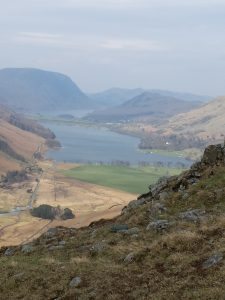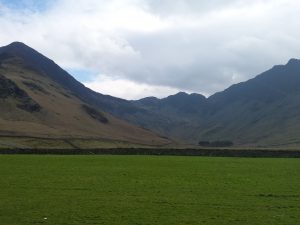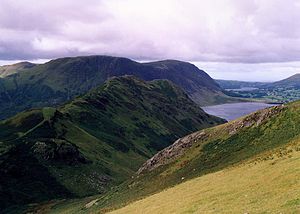There’s a lot of interest in the Norman Conquest just now, what with the 950th anniversary of the Battle of Hastings approaching. So I thought I’d post about a loosely related event up in the Lake District, in the adjoining valleys of Buttermere and Rannerdale. Today’s Buttermere is a quiet and peaceful spot, with only a small scattering of houses set along the valley. Rannerdale itself is entirely unpopulated.

Back in the 11th and 12th centuries, however, they are said to have been a centre of Cumbrian resistance to the Norman invaders. Northern England tried to prevent assimilation into Norman rule, and suffered very considerably by way of reprisals. Cumbria was at this time considered part of Scotland – this lasted until the mid 1200s – and its population derived heavily from Viking stock. It seems that there was no appetite for submitting to William the Conqueror or his representatives here.
So – allegedly – resistance focused around a man called Jarl Buthar, who established for himself a secure defensive position (some say that the name Buttermere is a corruption of Buthar’s Mere). It’s a good place to defend – if you don’t know the area, or you’re trying to move in with a substantial body of troops, there are not many options. You can come round the outside of the Cumbrian fells, requiring a long march and exposing your supply chain to endless harassment. Or you can try coming over what we now call the Honister Pass, a difficult and rugged journey which again leaves you at the mercy of those who know the land better. The side walls of the valley containing Buttermere and Crummock Water are out of the question.

So there Buthar dug himself in and conducted a guerilla war for the better part of 50 years. The Domesday Book of 1086 says nothing about the area, and we have to presume that it remained at liberty. Norman nobles tried several times to break in, but the region was only secured and subdued in the 12th century

Which brings us to Rannerdale (Ragnar’s Dale). As I mentioned, today it is a quiet offshoot from the main valley, nestling under the slopes of Whiteless Pike and Grasmoor. It is best known for a spectacular crop of bluebells, which unusually grow out in the open here rather than in woodland. But according to rumour it was the place where Buthar lured a group of Normans led by Ranulph les Meschines and then slaughtered them in an ambush. The bluebells originated from the blood of the fallen.
How much of the tale is truth and how much legend? It has to be said that archaeologists are sceptical of the account, largely through lack of supporting evidence, and a common idea is that it is a romanticised version of the last stand of the Cumbrians against the unstoppable Normans. Be that as it may, it has triggered at least two work of fiction – The Secret Valley: The Real Romance of Unconquered Lakeland, by Nicholas Size in 1930, and Shield Ring, by Rosemary Sutcliff in 1956.
When you have finished exploring it, there are the more sedentary delights of Buttermere Village, including Syke Farm with its splendid icecream and other menu items…
